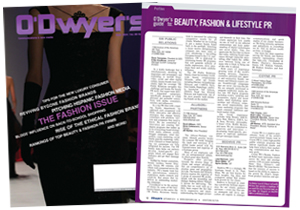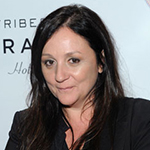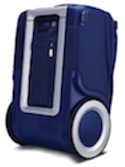|
|
Several big brands in the U.S. that push humanitarian concepts include Tom’s Shoes, John Hardy, American Apparel, and Everlane. John Hardy gives consumers a virtual tour of their facility in Bali on their website. Everlane employs supply chain transparency, Shinola emphasizes American craftsmanship, and French brand Sezane is open about their production facilities. Many of these brands have made headlines for their campaigns, and have even been featured in national fashion magazines (Marie Claire recently ran a front-of-the-book section highlighting ethical labels).
Other brands that are not as prevalent in the media, but employ ethically conscious practices, include Priya, Free Your Heart Apparel, Nomadic State of Mind, Sofia-Z, and Raleigh Denim. Online boutiques like Ethica and Zady showcase the story or information behind each item they carry. On the Ethica website, consumers can purchase “ethical” brands, and narrow them down by qualities such as: made in U.S.A., vegan, trade not aid, handcrafted, as well as sustainable characteristics, and most clothing items have more than one designation.
Cause becomes talking point
Jordan Landes-Brenman, CEO of Haute House PR & Marketing, represents several fashion brands and clients, including DARKOH, a menswear line that utilizes local-U.K. sourced fabrics. Landes-Brenman believes that people want to feel good about what they’re buying nowadays.
“We’re still shell-shocked after the recession, and though retail is certainly making a comeback, people have really changed their spending habits, and I don’t see this changing anytime soon,” Landes-Brenman said. “The market is so saturated with brands at this point, that a fashion line that stands out and does something humanitarian-conscious certainly can impact a consumer’s decision as to whether or not to purchase from them, over their competitor. I think this is something that is only going to continue to grow, and it’s something that is also being dictated by what we’re seeing published by influencers in fashion media.”
Landes-Brenman works with major fashion editors on a daily basis, and said she is seeing a trend that brands with humanitarian-conscious causes are generally given more consideration for a story than ones that do not.
There are fashion brands that directly support humanitarian efforts in third world countries. For example, Houston-based boutique jewelry company Priya began in 2011 by employing sex trafficking survivors in Kolkata, India, to hand-make their products, and has grown since then to include two other artisan groups over the last three years. The jewelry line also created The Priya Foundation, which benefits from proceeds to provide micro-grants to women entrepreneurs in developing nations.
Although the line is very conscious about providing relief and support to women, the brand is more popular with local magazines than on the national magazine scale. Publications like 002 Magazine, Houston Modern Luxury, and Young Houston Magazine have featured Priya products.
According to owner Joy Kennedy, “Most people who wear or promote Priya love to mention the humanitarian cause behind the brand.”
Endorsement possibilities abound
Celebrity support and advertisement may be one of the fastest and most widespread ways to show concern for fashion brands utilizing humanitarian decisions. Since many consumers base their purchasing decisions on celebrity endorsements, humanitarian and eco-conscious brands may begin to seek more support from the Hollywood industry. Celebrity gifting suites during awards season in Hollywood may be a method of creating humanitarian brand impressions. Nomadic State of Mind presented their handcrafted, recyclable shoes at the Secret Room Oscars gifting suite, pushing the appeal of their humanitarian label to fashion magazine editors and Hollywood celebrities that made an appearance. For the average consumer looking to buy the Nomadic State of Mind shoe, categories like organic apparel and sandals with soles are advertised on their website and contribute to a consumer’s feel-good purchase.
There are a number of celebrities currently endorsing or facilitating humanitarian clothing. Lauren Bush and Ellen Gustafson launched FEED Projects in 2007 with the aim of selling bags to defeat world hunger. Ralph Lauren has a history of supporting breast cancer charities with various “Pink Pony” products. Olivia Wilde, an actress who has starred in movies such as “Tron: Legacy” and “The Change-Up,” has recently developed the “Message Bag” in collaboration with Alternative Apparel, a company has pledged to give bags, backpacks and other supplies to the school throughout the year as part of the collaboration.
The $138 bag is a cross-body that converts to a backpack, featuring vintage army canvas, pebbled leather trim and antique brass hardware. 20% of the bag’s proceeds will go to Academy for Peace and Justice, which is screen-printed on the inside of the bag so buyers can remember exactly where their money is going.
“We are hoping to encourage people to consider where their dollars go, and to really understand the power of commerce. Your dollar is your vote, and everyone can really make a big difference because of that,” Wilde recently told Forbes.
Consumer shift certain, albeit slow
Alden Wicker, owner of highly popular eco-fashion blog, EcoCult, feels that many consumers are switching to American-made clothes and getting excited about American craftsmanship. However, she does not think that changes are happening swiftly enough.
“Until the Rana Plaza collapse in Bangladesh last year, I don’t think consumers really thought about where their clothes came from. Most just assumed that sweatshop conditions were a thing of the past, that Nike had fixed all that,” said Wicker. “But after Rana, suddenly women have been looking at their mounds of clothes and thinking that they might want to go in a new direction. Unfortunately, without a certification or standard labeling system, the most consumers can do right now is look at the label and make a semi-informed decision about what kind of conditions might be found in the country where the garment was manufactured and what kind of impact the textile has on the environment.”
Consumers have grown more conscious about where their clothing comes from and how it is produced, but it is not clear on what scale this consciousness has occurred to promote widespread change. There are many brands that are creating messages to address this newfound consumer awareness, like worker facility tours, donations, and website advertising. The question remains on whether brands are making real, long-term changes to address socially responsible consumers. There seems to be some promotion among the major fashion magazines to inspire consumers to purchase humanitarian conscious brands.
“People have been concerned about what is in their food and how their food is made for some time. It was only a matter of time until they applied that same judgment to choosing clothing,” said Wicker. “Now when women find a $5 shirt, their response isn’t so enthusiastic. It’s more like, this was obviously made by a slave child, how else could it be so cheap?”
* * *
Adrienne Jordan is a freelance travel and lifestyle writer based in Los Angeles. She contributes to publications like USA Today, The Washington Times, and Just Luxe.



 Kim Kardashian West is using Full Picture PR for a $200M alliance with COTY Inc. to expand her KKW Beauty's product line and open new market categories.
Kim Kardashian West is using Full Picture PR for a $200M alliance with COTY Inc. to expand her KKW Beauty's product line and open new market categories. Fashion PR pro Kelly Cutrone has charged hip-hop mogul Russell Simmons with a rape attempt in 1991.
Fashion PR pro Kelly Cutrone has charged hip-hop mogul Russell Simmons with a rape attempt in 1991. Fashionable travel luggage and accessories are focusing on becoming more tech-centered to meet traveling and space-saving demands.
Fashionable travel luggage and accessories are focusing on becoming more tech-centered to meet traveling and space-saving demands. For lifestyle PR to be effective today, practitioners must lead with audience-centric strategies that meet consumers on the platforms they use, when they use them, with strong storytelling at its core.
For lifestyle PR to be effective today, practitioners must lead with audience-centric strategies that meet consumers on the platforms they use, when they use them, with strong storytelling at its core. Celebrities have always played a key role in the marketing landscape. But companies eager to tap into social media channels are now making a conscious shift to include influencers in their online marketing plans, with the fashion and beauty industries leading the charge.
Celebrities have always played a key role in the marketing landscape. But companies eager to tap into social media channels are now making a conscious shift to include influencers in their online marketing plans, with the fashion and beauty industries leading the charge.


 Have a comment? Send it to
Have a comment? Send it to 
No comments have been submitted for this story yet.